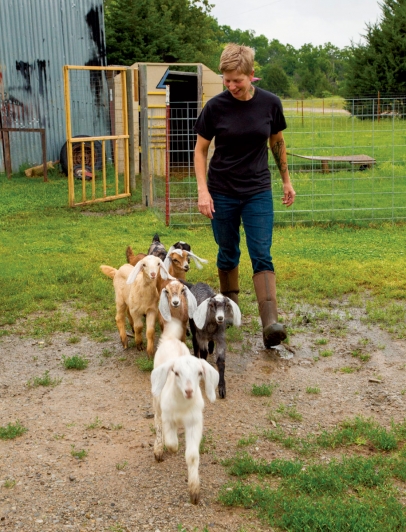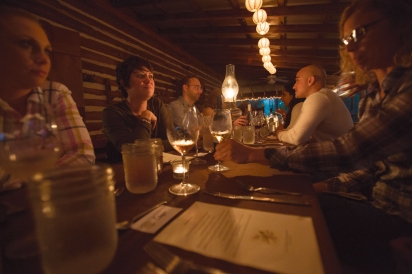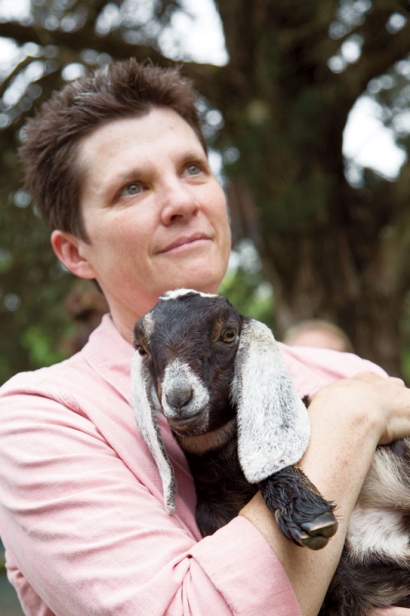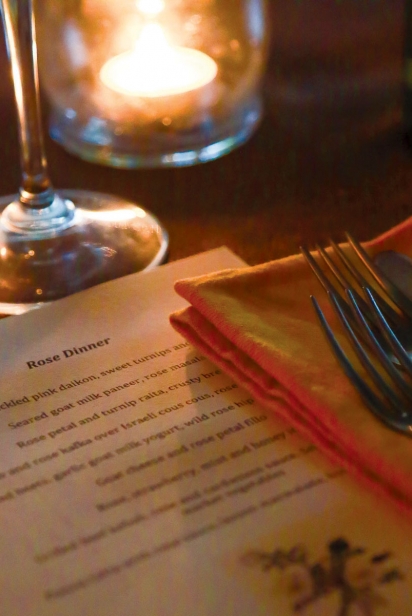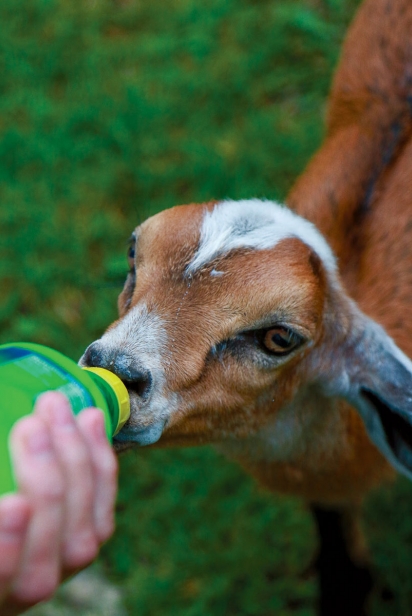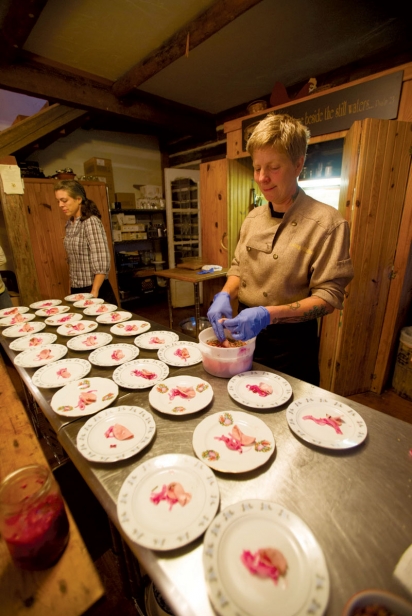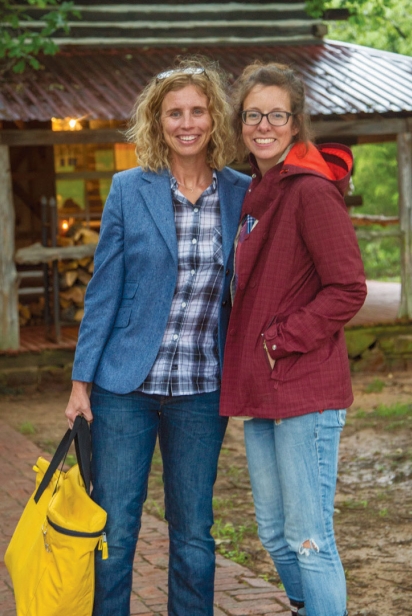Paradise with a Porch: The Living Kitchen Farm Table Dinners
From May to October, the hottest table to snag for dinner in Tulsa isn’t in the hippest new restaurant, or even in Tulsa, but rather several dozen miles west on historic Route 66, down a gravelly dirt road, past a large pond and onto perhaps the greatest screened-in porch in the state.
It is no secret that Oklahoma has had its share of rain over the last few weeks—record rainfall at that—so when the Edible Tulsa crew pulled down said gravelly dirt road leading to our dinner reservation the clouds overhead seemed ready to open up on us at any moment. To say we were somewhat dubious was an understatement.
Almost as soon as we pulled up to the Living Kitchen Farm and Dairy, we were greeted by a crew of enormous and extremely muddy Great Pyrenees dogs. Some of us were immediately rethinking clothing choices. Luckily I had the forethought to wear tall rain boots, in anticipation of a possible farm tour.
The catalyst for the Living Kitchen Farm and Dairy is by all means farm to table, with the table being the hardest to attain. Lisa Becklund and Linda Ford host themed dinners most weekends from May to October, and the events sell out almost as quickly as they go online. Each dinner—weather permitting—begins with a tour of the organic farm, followed by a multicourse meal, served at a large communal farm table on a screened-in porch. We were there for the Rose Dinner, but the Heirloom Tomato, Lavender and Pig Roast dinners are also popular choices. Resident chef (and head gardener, among other things) Lisa Becklund creates each dish with the theme in mind and based on what ingredients can be either foraged on the farm or procured locally.
To the casual observer of this 400-acre farm an hour outside of Tulsa, there is little to hint at the meal to come. Linda Ford, the other half of the dynamic duo that run Living Kitchen Farm and Dairy, met us and wrangled the greeting committee into their outside pen. As we chatted, the remaining two dozen guests arrive for the pre-dinner orientation. Becklund joined the group, and just as the rain started its gentle descent, they let out a small herd of baby goats for feeding—a few guests jumped at the chance to bottle-feed the darling kids. We all considered ourselves lucky to be there. One of the goats trotted up to Ford’s ankles and without hesitation, she picked her up for a cuddle.
The vegetable fields where the majority of the produce is grown were too bogged down for a tour, so the group made its way farther down the road to the cabin, where dinner would be held. This spot is inescapably a product of the country: The rustic log cabin blends seamlessly with the forest and fields surrounding it, and the small creek that runs next to it is trickling at a gentle clip through the area, thanks to the rain. Becklund was in the cabin’s kitchen, readying our first course (rose-pickled pink daikon, sweet turnips and beets) as guests made their way through to the dreamy porch.
As the farm-to-table movement swoops across America, Becklund is preaching, as well as living, the gospel of natural foods. But she didn’t come about farming through family or even location. The Washington State native was born and raised in Seattle’s restaurant scene.
“I have fish and restaurants in my DNA,” she says. From a young age she scurried around The Wharf, her aunt and uncle’s decades-old restaurant at Fisherman’s Terminal that catered to Seattle’s upper class as well as the local fishing community. Becklund says that fishermen gulped hot coffee by the gallons in the morning and whiskey in the evening in the café.
After culinary school and an apprenticeship at the then-Stouffer Madison Hotel, Becklund made the rounds through some of Seattle’s restaurants, eventually opening her own very successful restaurant in 1996. But there was always a craving to learn more about the food she was cooking, so Becklund left Seattle for a small seven-acre farm in Oklahoma.
“It was hard like I had never known before and heartbreaking, but I was in love with Oklahoma and the friendships I made were just too important to leave, so I forged on.” Becklund was farming and raising goats on whatever land was producible but she wasn’t able to grow the farm any larger.
On a hot August day six years ago Becklund had all but decided to give it up and return to Seattle. That same afternoon, while out milking the goats, she received a call from Heather Oakley (founder and director of Global Gardens in Tulsa).
“My dad has a 400-acre farm in need of a caretaker,” Oakley said. “Would you know anyone who is interested?” Becklund got in her car and drove to the Oakley farm in Depew.
“Our single purpose is the continual journey to raise, grow and forage the perfect meal.”
—Living Kitchen Farm and Dairy
“I walked around and couldn’t believe it was real,” Becklund says. “We sat on the back porch of the cabin for hours talking about the serendipity of the situation. I had surrendered, but Oklahoma wanted me to stay.”
Becklund’s partner in life and on the farm, Linda Ford, didn’t grow up on a farm either, but her hometown just south of Kansas City was surrounded by them. Ford spent many years living and working in large cities around the world but longed to be more connected to the natural world. She found the Living Kitchen when joining friends who were farm-sitting for Lisa, giving her a much-needed break. Ford moved to the farm in 2009, but still straddles two worlds - one working a full time job and another caring for animals, tending the garden and working with Lisa on the Farm Table Dinners.
The Living Kitchen Farm and Dairy raises and produces certified organic heirloom vegetables, milk goats and around 400 pastured laying hens—an assortment of Barred Rock, Easter Egg and Black Sexlink— along with a few pet sheep and Pascal the llama, whose sole job involves keeping the goat herd safe from coyotes and other predators. The little goats wait patiently at the gate every morning for him to wake before venturing out into the pasture together.
In better weather, guests would be able to walk among plots of heirloom carrots, Tokyo turnips, eggplant, peppers and some 20 varieties of heirloom tomatoes, just for starters. Becklund and Ford also forage for many wild ingredients—reindeer moss, wood sorrel, poke and lamb’s quarters, to name a few—for some of the events, including the Found and Foraged dinner. Goat’s milk is used to make fresh chèvre, which is used exclusively at the dinners. Becklund and Ford have tried their hand at raising beef, but now get the majority of their meat from Blakely Family Farms. And of course this is a farm, so there are chickens ...
Eggs from the farm’s hens, as well as a fair amount of the certified organic produce, go to Tallgrass Prairie Table restaurant in Tulsa. Chef Michelle Donaldson has set the pace for Tulsa’s local food movement, sourcing not only from Living Kitchen but other farms, ranches and dairies around the area. I asked Becklund about the farm-to-table movement happening now.
“I’m all for it,” she says. “I’m just sad it took so long to catch on in Tulsa, but it’s here now. Tallgrass is making a huge effort—I can see it from the menu changes and by what is available in the walk-in.”
Tallgrass Prairie Table has helped out Living Kitchen in other ways. Back in the fall of 2014 the farm’s tractor broke down. Ford and Becklund struggled to come up with the cash needed to get it repaired, and struggled further by not being able to use the tractor in the prime of harvest. The restaurant stepped up and threw a “Tractor Dinner” to help cover the costs. Over 150 guests quickly bought tickets and 100% of the proceeds went directly to the farm. The dinner raised much more than they needed to fix the tractor, so Becklund and Ford continued to pay it forward by giving the excess proceeds to others in need.
The Living Kitchen Farm Table Dinners have become so popular, and so much work, that Becklund and Ford had to give up their booth at the Tulsa Farmers’ Market as well as CSA memberships.
“I want to make the best dinners I am capable of,” Becklund says. “I am only concerned with what is out in my field and what is available at the local farmers’ markets.”
The dinners for the rest of 2015 have long been sold out, but customers can mark their calendars for next year—tickets will go on sale sometime in early March for the first few months, and again in early June for late summer and fall dinners. Until then we can only think back to the night we sat on the screened-in porch, dining on a nine-course dinner infused with rose, listening to the rain pour down. Remember that creek I mentioned earlier? The one trickling by the cabin? It was a roaring stream by the time dinner was over, and several cars had to be pulled from the mud in order to leave. Nonetheless, everyone in attendance left with the same feeling: nourishment for the soul as well as the tummy!
For more information, including how to sign up for next year’s dinners, visit LivingKitchenFarmAndDairy.com.


